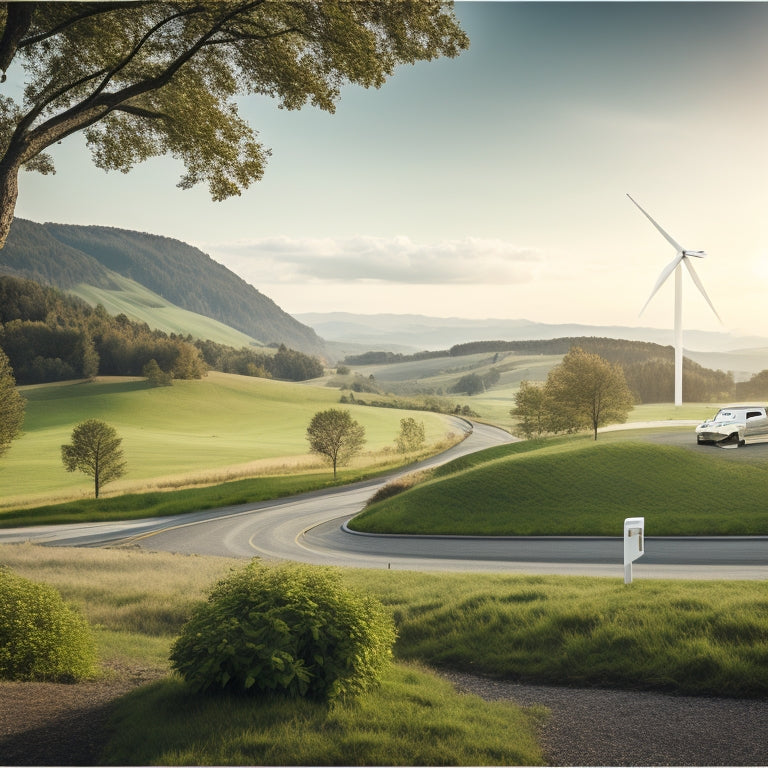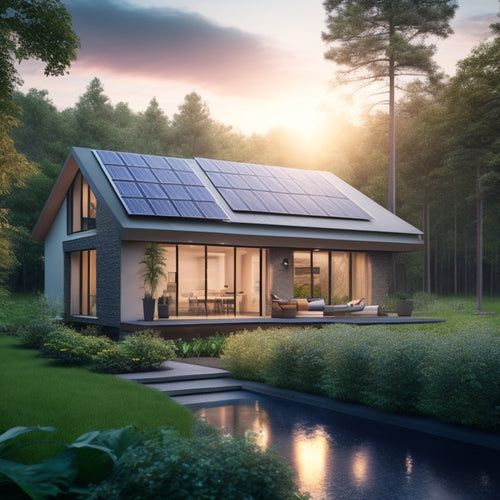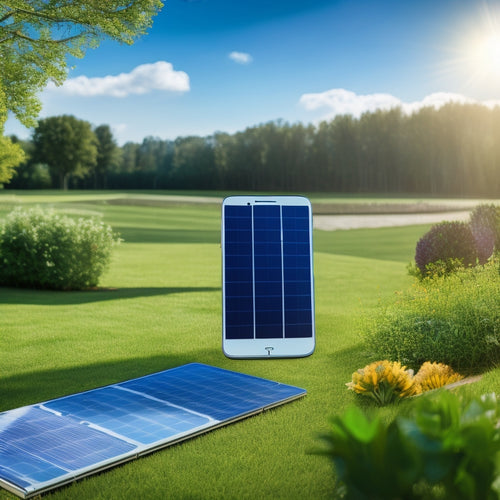
Why Combine Wind Power With EV Charging?
Share
By combining wind power with EV charging, you're utilizing renewable energy sources to reduce your carbon footprint and reliance on fossil fuels. This clean technology collaboration enables energy autonomy, decentralizes power distribution, and supports a circular economy. You'll experience significant decreases in greenhouse gas emissions and air pollutants, leading to improved public health and air quality. As you shift to a greener future, you'll not only minimize your environmental impact but also enjoy lower electricity bills and a seamless EV charging experience. Now, investigate the full benefits of integrating wind power and EV charging to accelerate your expedition towards a sustainable tomorrow.
Key Takeaways
- Combining wind power with EV charging reduces reliance on fossil fuels, decreasing greenhouse gas emissions and air pollutants for a cleaner environment.
- Wind power-generated electricity charges EVs efficiently, leveraging excess energy and stabilizing the grid for a reliable power supply.
- This synergy promotes energy autonomy, decentralized systems, and community control over energy needs, supporting a circular economy and sustainable infrastructure.
- By aligning EV charging with wind turbine output, charging infrastructure optimization minimizes waste, maximizes savings, and contributes to a carbon-neutral future.
- The integration of wind power and EV charging drives technological innovation, policy support, and education on renewable energy, ensuring a healthier planet for future generations.
Harnessing Renewable Energy Sources
You're likely aware that our reliance on fossil fuels is unsustainable, and renewable energy sources are becoming increasingly important. As you investigate alternatives, utilizing renewable energy sources is essential for a sustainable future.
Renewable integration, like wind collaboration, enables the efficient use of clean technology. Large-scale solar farms provide a clean and abundant energy source, lessening fossil fuel dependence and stabilizing the grid with energy storage systems.
Developing sustainable infrastructure that incorporates energy storage and grid resilience is critical for a circular economy. Effective resource management and community engagement are also fundamental for successful policy support.
Reduced Carbon Footprint Benefits
When you combine wind power with EV charging, you're effectively evolving to cleaner energy sources that reduce your reliance on fossil fuels.
This shift leads to lower emissions today, contributing to a significant decrease in greenhouse gases and air pollutants.
By investing in renewable energy infrastructure energy independence, organizations can further minimize their environmental impact and operating costs.
As you continue to utilize wind energy, you're laying the groundwork for a greener tomorrow ahead.
Cleaner Energy Sources
By integrating wind power with EV charging, individuals can greatly reduce their reliance on fossil fuels, thereby minimizing their carbon footprint and contributing to a cleaner environment.
You'll be supporting a more sustainable energy future, and that's something to feel good about. Additionally, wind-powered EV charging stations can be designed with sustainable station designs featuring green roofs, rainwater harvesting, and solar panels, further enhancing their eco-friendliness Renewable Energy Sources.
-
Energy diversification: Reducing dependence on a single energy source enhances grid stability and promotes sustainable practices.
-
Policy incentives: Governments often offer incentives for adopting renewable energy sources, which can help offset the cost of wind site selection and installation.
-
Community engagement: Wind-powered EV charging stations can serve as community hubs, cultivating education and awareness about the importance of renewable energy.
-
Battery storage: Storing excess wind energy in batteries guarantees a reliable power supply, even when the wind isn't blowing.
-
Solar integration: Combining wind and solar power can provide a consistent, renewable energy supply, further reducing your carbon footprint.
Lower Emissions Today
A cleaner environment is within reach as wind power combines with EV charging to considerably reduce emissions.
You'll be contributing to a significant decrease in air pollution, which is a major benefit of sustainable transportation.
By utilizing wind energy to power your electric vehicle, you're effectively cutting down on greenhouse gas emissions from fossil fuels.
This emission reduction translates to improved air quality, protecting not only the environment but also public health.
With the utilization of renewable energy sources, the carbon footprint is minimized, and clean energy usage is maximized.
As you charge your EV using wind power, you're taking an essential step towards minimizing your carbon footprint, leading to a cleaner, healthier future.
Greener Tomorrow Ahead
As you drive your electric vehicle, powered by wind energy, you're not only reducing emissions today but also laying the groundwork for a greener tomorrow.
By combining wind power with EV charging, you're contributing to a sustainable infrastructure that will benefit future generations. This collaboration also encourages community engagement, encouraging public awareness and education on the importance of clean transportation.
Integrating green energy storage systems advanced technologies allows for efficient and sustainable EV charging, minimizing environmental impact and promoting energy independence.
Some key benefits of this integration include:
- Smart grids that efficiently manage energy distribution and storage
- Policy incentives that drive technological advancements and economic viability
- Grid integration that enables widespread adoption of renewable energy sources
- Increased energy independence, giving you more control over your energy usage
- A significant step towards a carbon-neutral future, ensuring a healthier planet for years to come
Increased Energy Independence
Since adopting renewable energy sources, you've likely noticed a significant decrease in your reliance on fossil fuels.
This shift towards energy autonomy is a vital step in achieving true energy sovereignty. By utilizing local resources like wind power, you're not only reducing your carbon footprint but also strengthening grid resilience.
Decentralized systems, like community-based wind farms, enable individuals and communities to take control of their energy needs. This technological innovation paves the way for sustainable infrastructure, allowing you to break free from the shackles of fossil fuels.
As you combine wind power with EV charging, you're accelerating your path towards energy independence, where you're the ruler of your own energy destiny.
Lowering Electricity Bills Fast
You're reaping the benefits of energy independence, and now it's time to tackle the financial upside. By combining wind power with EV charging, you're ready to lower your electricity bills fast.
This powerful duo helps you manage your energy costs more effectively, allowing you to:
- Reduce your reliance on the grid and lower your electricity expenses
- Shift your energy usage to off-peak hours, taking advantage of lower rates
- Optimize your energy storage and consumption, minimizing waste and maximizing cost savings
- Make data-driven decisions about your energy usage, refining your budget management strategy
- Enjoy long-term savings and a reduced carbon footprint, giving you peace of mind and freedom from energy uncertainty
Maximizing Wind Turbine Efficiency
You can maximize wind turbine efficiency by optimizing turbine performance, which involves fine-tuning blade pitch, yaw, and rotor speed to match changing wind conditions.
This optimization increases energy yield, allowing you to generate more power from the same turbine.
Additionally, power curve smoothing helps to reduce fluctuations in output, ensuring a more stable and reliable supply of electricity for EV charging.
Turbine Performance Optimization
Tapping into the full potential of wind turbines requires fine-tuning their performance. As you work to maximize efficiency, you'll need to focus on turbine performance optimization.
This involves regular turbine maintenance to guarantee that your machines are running smoothly and effectively utilizing the wind resource. By doing so, you'll be able to:
- Increase energy production and reduce costs
- Extend the lifespan of your turbines
- Improve overall system reliability
- Enhance real-time monitoring and control capabilities
- Optimize performance in varying wind conditions
Energy Yield Increase
Optimizing energy yield is vital to maximize wind turbine efficiency. By combining wind power with EV charging, you can increase energy yield through various means. One way is by utilizing energy storage systems to store excess energy generated by the wind turbine during off-peak hours, which can then be used to charge EVs during peak hours. This approach enables better grid integration and demand response management.
| Energy Yield Increase Strategies | Description |
|---|---|
| Energy Storage Systems | Store excess energy for later use |
| Charging Infrastructure Optimization | Optimize EV charging times to match wind turbine output |
| Renewable Collaboration | Combine wind power with other renewable sources for increased efficiency |
Moreover, advances in technology and policy incentives can improve the economic feasibility of wind-EV charging systems, leading to increased user adoption and a more sustainable energy future. Effective power management is significant to guarantee a seamless integration of wind power and EV charging.
Power Curve Smoothing
By utilizing the full potential of wind turbines, power curve smoothing enables the maximization of wind turbine efficiency. You can think of it as an optimized power management strategy that guarantees a steady output, even when wind speeds are inconsistent. This is vital, as wind turbines typically operate at their maximum capacity only 45% of the time.
Here's what power curve smoothing can do for you:
- Reduce strain on the turbine, increasing its lifespan
- Provide a stable and predictable energy output
- Allow for more accurate forecasting and planning
- Enable more efficient energy storage and release
- Help you make the most of your wind power investment
Seamless EV Charging Experience
As you plug in your electric vehicle (EV) at a wind-powered charging station, the charging process begins seamlessly, thanks to advanced technology that guarantees a hassle-free experience.
This seamless user experience is made possible by the integration of innovative solutions that prioritize user accessibility and convenience features.
The charging infrastructure is designed to assure grid compatibility, allowing for efficient energy management and maximizing the potential of wind power.
Moreover, technology integration enables real-time monitoring and customer engagement, providing you with a seamless and convenient charging experience.
With advanced charging networks, you can enjoy the freedom to charge your EV whenever and wherever you need to, without worrying about the logistics.
Environmental Impact Mitigation
Your seamless EV charging experience at a wind-powered station isn't only convenient but also environmentally responsible.
By combining wind power with EV charging, you're contributing to a cleaner, more sustainable future.
- You're reducing greenhouse gas emissions and mitigating climate change
- You're preserving ecosystems and protecting biodiversity
- You're supporting community engagement and education on sustainable practices
- You're driving technological innovation in energy storage and grid integration
- You're advocating for policy structures, economic incentives, and regulatory support for a cleaner energy future
Future-Proofing Your Home Energy
Sustainability converges with innovation in the domain of home energy management. When you combine wind power with EV charging, you're not only reducing your carbon footprint but also future-proofing your home energy.
With energy storage and home automation, you'll have greater control over your energy usage. Smart technology integrates your system with the grid, ensuring a seamless shift between wind power and traditional energy sources.
This setup enables sustainable living, climate resilience, and energy monitoring. Community support and future innovations will further enhance your system's efficiency.
As policy implications evolve, your setup will be ready to adapt, ensuring you're always at the forefront of renewable energy. By investing in this technology, you're securing a cleaner, more independent energy future for yourself and your community.
Frequently Asked Questions
Can I Use Wind Power for EV Charging if I Don't Own a Turbine?
Fasten your seatbelt, pioneer! Even without owning a turbine, you can utilize wind power for EV charging through community wind projects, shared resources, and renewable partnerships, making local initiatives a viable option for sustainable energy freedom.
Will Combining Wind Power and EV Charging Increase My Electricity Bills?
When you combine wind power with EV charging, you'll likely reduce your electricity bills, as you're generating free energy, offsetting consumption; however, consider upfront costs and potential grid connection fees, which may impact overall cost implications, but still yield long-term energy savings.
How Much Space Is Required for a Wind Turbine and EV Charging Station?
You'll need around 1-2 acres for a wind turbine, depending on turbine spacing, and approximately 10-20 square feet for an EV charging station, which can be integrated into existing charging infrastructure, giving you freedom to utilize renewable energy.
Are There Government Incentives for Wind-Powered EV Charging Systems?
You're likely to strike gold with government incentives for wind-powered EV charging systems, as you'll uncover a wealth of benefits, including lucrative government grants and tax rebates, which can greatly offset your initial investment costs.
Can Wind Power Be Used to Charge Electric Vehicles During Power Outages?
You can utilize wind energy benefits to charge electric vehicles during power outages by integrating renewable energy integration systems that store excess energy in batteries, ensuring a reliable, clean power source when you need it most.
Related Posts
-

3 Best Eco-Grants for Home Energy Upgrades
You're eligible for various eco-grants that can help you cut down on energy bills and reduce your carbon footprint by...
-

Why Biodegradable Dish Soap Matters for Earth-Conscious Homes
You likely don't realize that the dish soap you're using today will still be harming the environment long after you'v...
-

7 Best Solar Panel Upkeep Apps for Homeowners
You can optimize your solar panel's energy output and efficiency by up to 20% with regular maintenance, which is wher...


